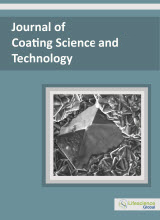jcst
Abstract : Osteoblast Behavior on Silicon and Porous-Silicon Substrates
|
|
|
Abstract: Osteoblast viability, proliferation, protein expression and mineralization were studied on bare, micro- and nanoporous silicon (Si) substrates. Micro- and nano-porous-Si substrates were prepared by anodic etching of silicon in ethanolic hydrofluoric acid and characterized using scanning electron and atomic force microscopies. Mouse osteoblasts were cultured on these substrates and cellular response to these surfaces was assessed using the Live/Dead Cell Viability assay and the MTT assay for cell proliferation. Osteoblast functionality was assessed using immunohistochemistry for bone protein specific markers. Osteoblasts grew well on micro- and nanoporous silicon substrates over the twenty-one day experimental period supporting the assessment that these are suitable cell supportive surfaces. Cell proliferation rates on bare and nanoporous silicon were similar initially, however, nanoporous silicon displayed enhanced cell proliferation, in comparison to bare silicon, after 14 days in culture. Immunocytochemical assays, using bone specific markers, showed positive reactions for osteonectin and osteopontin expression on all substrates with staining intensity increasing over the 21-day experimental period. Calcium mineral deposits were quantified using the Alizarin Red histochemical assay and nanoporous silicon induced the highest level of calcium mineral production in comparison to bare and microporous silicon. The data supports the potential use of nanoporous silicon as a surface implant coating for dental and orthopedic applications. The ability to dope (and then release) drugs or growth factors from the silicon nanopores offers the potential for a multi-functional implant surface.. Keywords: Porous-Si, anodic etching, implant surfaces, osteoblasts. |
Abstract : Structure, Mechanical and Tribological Properties of HVOF Sprayed (WC-Co+Al) Composite Coating on Ductile Cast Iron
|
|
|
Abstract: The paper presents the results of examinations of WC-Co coating sprayed on ductile cast iron by high velocity oxygen fuel spray process (HVOF) with powder containing Al particles in an amount of 10%. The impact of Al particles added to the tungsten carbide coating on the structure, mechanical and tribological properties in the system of (WC-C)/ductile cast iron was examined. The microstructure of the thermal sprayed WC-Co+Al coating was characterized by light, scanning electron (SEM) and transmission electron (TEM) microscopes as well as the analysis of chemical and phase composition in micro areas (EDS, XRD). It was found that by supersonic thermal spraying with WC-Co powders with the addition of Al particles, the coatings of low porosity, high hardness, a very good adhesion to the substrate, compact structure with molten Al particles and finely fragmented WC particles embedded in a cobalt matrix, reaching the nanocrystalline sizes were obtained. Moreover, the results were discussed in reference to examination of bending strength considering cracking and delamination in the system of (WC-Co+Al)/ductile cast iron as well as hardness and wear resistance of the coating. It was found that the addition of Al particles was significantly increase resistance to cracking and wear behaviour in the studied system. Keywords: WC-Co coating, Thermal spraying, HVOF, wear resistant, ductile cast iron. |
Abstract : Peculiarities of Electron-Beam Formation of Hydrophobic and Superhydrophobic Coatings Based on Hydrocarbons of Various Molecular Weights and PTFE
|
|
|
Abstract: The paper studies the possibility of superhydrophobic coatings formations at exposure of powder mixture of polytetrafluorethylene and hydrocarbons having various molecular weights to low-energy electron beam in vacuum. It is shown that paraffin and PTFE based thin composite coatings may be characterized by superhydrophobic properties. The superhydrophobic properties are attained due to low surface energy of the fluorine-containing component and structured surface due to peculiarities of composite layer formation. The chemical processes observed in electron beam exposed area determine the molecular structure, morphology and the contact angle of thin organic coatings deposited. It is shown that high-molecular-weight hydrocarbon compounds should not be recommended for vacuum electron-beam deposition of superhydrophobic thin coatings because of deep changes in the molecular structure exposed to electron beam. These processes are responsible for high degree of unsaturation of the thin layer formed and for occurrence of oxygen-containing polar groups. The influence of substrate temperature on molecular structure, morphology and hydrophobic properties of thin coatings deposited is investigated. Potentially such coatings may be applied for deposition on the surface of metal capillaries used in biotechnological analyzers. Keywords: Electron-beam deposition, superhydrophobic coatings, paraffin, polytetrafluorethylene, molecular structure, nanocomposite coatings. |
Abstract : Wear-Resistant Nanostructured Sol-Gel Coatings for Functional Applications
|
|
|
Abstract: Improvement of the wear resistance of functional surfaces is crucial in order to facilitate a variety of practical applications, such as self-cleaning or anti-fogging. This especially holds for functional surface nanostructures, whose tops can easily get worn off when exposed to even low abrasion forces. Thus, our work addresses the enhancement of the wear resistance of such fine-scale structures. We present an efficient manufacturing procedure for generating long-term durable surfaces with simultaneously tailored wetting behavior and high optical quality. Our approach is based on a sol-gel coating that consists of an alumina layer with specific nanoroughness yielding the function-relevant surface structure, and a protective thin smooth silica film providing the mechanical robustness without influencing that functional structure. The roughness of the alumina layer can be systematically adjusted, thus enabling us to achieve desired wetting effects all the way up to superhydrophilicity and, after application of an additional thin hydrophobic top coat, to superhydrophobicity. To demonstrate the enhanced robustness of these coatings we perform abrasive wear tests and investigate the impact of abrasion cycles on the wetting effects and optical properties of the coatings. Furthermore, the durability of the structures is directly revealed by advanced roughness characterization procedures based on Atomic Force Microscopy followed by power spectral density function (PSD) analysis. Keywords: Durable thin film coating, Surface roughness, Wetting, Superhydrophobic surface, Superhydrophilic surface, Optical coating, Scatter losses. |






















